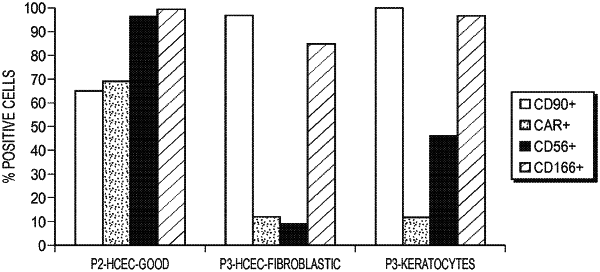| CPC G01N 33/56966 (2013.01) [C12N 5/0621 (2013.01); G01N 33/5064 (2013.01)] | 20 Claims |

|
1. A method of forming a composition enriched with human corneal endothelial cells comprising:
contacting a cell population containing human corneal endothelial cells expressing CD56 or CD166 with a first positive affinity reagent; and
selecting cells to which the first positive affinity reagent is bound,
wherein the first positive affinity reagent comprises an antibody that binds to CD56 surface protein expressed on the surface of human corneal endothelial cells, an antibody that binds to CD166 surface protein expressed on the surface of human corneal endothelial cells, an antibody that binds to coxsackievirus and adenovirus receptor (CAR) surface protein expressed on the surface of human corneal endothelial cells, or an antibody that binds to CD248 surface protein expressed on the surface of human corneal endothelial cells;
wherein the method comprises one or both of:
(i) the human corneal endothelial cells in the cell population express CD56, the first positive affinity reagent comprises an antibody or aptamer that binds to CD248 surface protein expressed on the surface of human corneal endothelial cells, an antibody or aptamer that binds to CAR surface protein expressed on the surface of human corneal endothelial cells, or an antibody or aptamer that binds to CD166 surface protein expressed on the surface of human corneal endothelial cells, and
(ii) further comprising:
contacting the cell population containing human corneal endothelial cells with a second positive affinity reagent; and
selecting cells to which the second positive affinity reagent is bound;
wherein the second positive affinity reagent differs from the first positive affinity reagent in regard to the identity of at least one surface protein that the first and second positive affinity reagents bind to and the second positive affinity reagent comprises an antibody or aptamer that binds to CD56 surface protein expressed on the surface of human corneal endothelial cells, an antibody or aptamer that binds to CD90 surface protein expressed on the surface of human corneal endothelial cells, an antibody or aptamer that binds to CD166 surface protein expressed on the surface of human corneal endothelial cells, an antibody or aptamer that binds to CD248 surface protein expressed on the surface of human corneal endothelial cells, or an antibody or aptamer that binds to CAR surface protein expressed on the surface of human corneal endothelial cells.
|
|
10. A composition enriched with human corneal endothelial cells comprising:
human corneal endothelial cells expressing at least one marker selected from the group consisting of: CD56, CD90, CD166, and coxsackie virus and adenovirus receptor (CAR); and
a first positive affinity reagent, wherein the first positive affinity reagent is an antibody against a surface protein expressed on the surface of human corneal endothelial cells, the surface protein selected from the group consisting of: CD56, CD90, CD166, CD248, and CAR,
wherein the marker expressed on the human corneal endothelial cells and the surface protein detected by the first positive affinity reagent are compositionally different;
wherein at least one of:
(i) the human corneal endothelial cell expresses CD56 and the first positive affinity reagent comprises an antibody or aptamer that binds to CD248 surface protein expressed on the surface of human corneal endothelial cells, an antibody or aptamer that binds to CAR surface proteins expressed on the surface of human corneal endothelial cells, an antibody or aptamer that binds to CD166 surface protein expressed on the surface of human corneal endothelial cells, or an antibody or aptamer that binds to CD90 surface protein expressed on the surface of human corneal endothelial cells and
(ii) the human corneal endothelial cell expresses CD56 and the first positive affinity reagent comprises an antibody or aptamer that binds to CD248 surface protein expressed on the surface of human corneal endothelial cells, an antibody or aptamer that binds to CAR surface protein expressed on the surface of human corneal endothelial cells, or an antibody or aptamer that binds to CD166 surface protein expressed on the surface of human corneal endothelial cells.
|